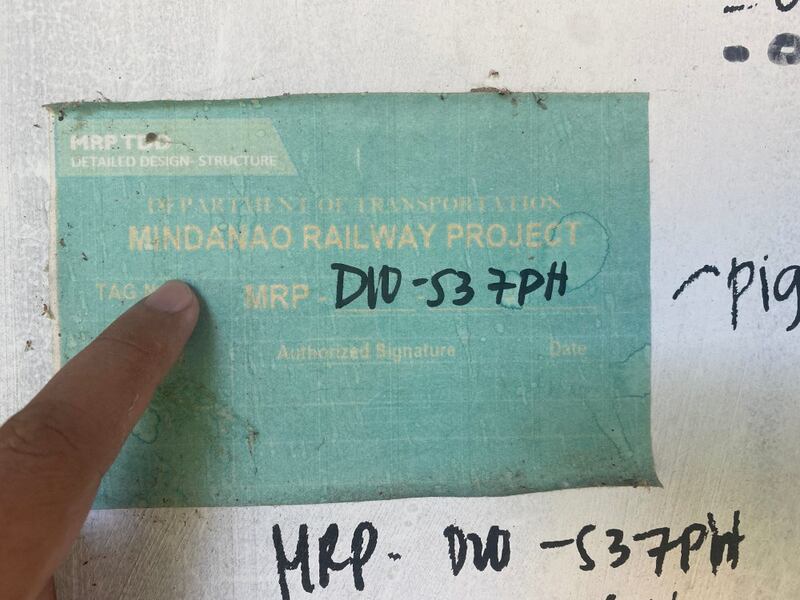The Philippines will no longer seek financial aid from China for a package of ambitious railway projects, the transportation secretary said, adding that officials were confident the projects could move ahead with funding from interested sources.
China had been slated to build two of the rail lines on the main Philippine island of Luzon and the third on southern Mindanao island, officials said.
The Marcos administration announced the decision to drop the Chinese loans amid tensions between Manila and Beijing in the South China Sea and days after a pair of minor collisions in disputed waters between ships and boats from both nations.
Philippine Transportation Secretary Jaime Bautista said the territorial tensions were not tied to this decision.
“We have three projects that won’t be funded by the Chinese government anymore. We can’t wait forever and it seems like China isn’t that interested anymore,” Bautista told a forum of German and Philippine businessmen in the financial district of Makati on Wednesday. “So, our government is looking for other sources of funding.”
The projects, carrying an estimated total cost of U.S. $4.9 billion, were part of the " Build, Build, Build" program, which former President Rodrigo Duterte had promoted as an offshoot of his administration's friendly policy toward China.
Bautista identified the projects as a 380-km (236-mile) railway from Laguna province, south of Manila, to Bicol province, on the southern end of Luzon; a 71-km (44-mile) railway to connect the Subic Bay Freeport Zone to the Clark Freeport Zone; and the first phase of the Mindanao Railway Project. For decades until the 1990s, Subic Bay and Clark Freeport Zones housed U.S. military bases.
While Chinese firms along with Philippine workers were to construct the rail projects, new contractors would be determined once funding is secured from other nations and sources, officials said.
Less than a month after Duterte left office in mid-2022, Ernesto Pernia, who had served as his socioeconomic planning secretary, said the Philippines would be wise to drop the three Chinese-backed projects.
“Much better to deal with ODA with Japan, South Korea, Australia, the U.S. and the E.U.,” Pernia told BenarNews, an RFA-affiliated news outlet, at the time while using an acronym for official development assistance.
Senators speak out
On Thursday, Sens. Grace Poe and Sherwin Gatchalian urged President Ferdinand Marcos Jr. and his administration to seek other sources of financing.
“The withdrawal of the official development assistance from China for a railway project should not derail the implementation of our infrastructure programs,” Poe told reporters.
“While appearing attractive, the loans are not exactly that benevolent as they come with hefty interest rates and other strings that could be detrimental to the country in the long term,” Poe said, noting that Chinese banks had kept the Philippine government “in suspended animation” with delays in the country’s loan applications.

Rates through the China-based lending agency Asian Infrastructure Investment Bank (AIIB), were “significantly higher” compared to funding from Japan or South Korean ODAs, Gatchalian said.
“You have to remember, ODAs are still considered loans even though they’re concessionary in nature,” he told reporters. “[T]he taxpayers will pay for it.”
In July 2022 when Pernia spoke out against Chinese funding, Beijing’s embassy in Manila issued a statement blaming the COVID-19 pandemic for some of the delays.
“As to infrastructure, China has comprehensive strength and is well-known for its quality and speed. China will tap its own advantage and support the Philippines to improve its infrastructure. Our two sides have been negotiating technical issues and made positive progress to move the projects forward,” the embassy said at the time.
South China Sea
The Philippines and China have traded accusations over the collisions at sea on Oct. 22 that involved coast guard ships near Ayungin (Second Thomas) Shoal, where Manila maintains a rusted World War II-era ship as its military outpost.
As he hosted Australian Prime Minister Anthony Albanese in Washington on Wednesday, U.S. President Joe Biden delivered a warning to China.
Biden criticized Chinese ships for acting "dangerously and unlawfully as our Philippine friends conducted a routine resupply mission within … their own exclusive economic zone in the South China Sea," according to a transcript from the White House.
“I want to be very clear: The United States’ defense commitment to the Philippines is ironclad,” Biden said. “Any attack on the Filipino aircraft, vessels, or armed forces will invoke our Mutual Defense Treaty with the Philippines.”
In an apparent response to Biden, the Chinese Embassy in Manila on Thursday said that the “escalation of activities has been inflated by the U.S. actions.”
“Since the beginning of this year, the U.S. has been blatantly emboldening the Philippines’ acts of infringing upon China’s sovereignty and inciting and supporting the Philippines’ attempts to repair and reinforce its warship that was deliberately grounded on Ren’ai Jiao,” it said, using the Chinese name for the shoal.
Basilio Sepe in Manila, and Jeoffrey Maitem in Cotabato City, Philippines, contributed to this report.
BenarNews is an RFA-affiliated news outlet.
